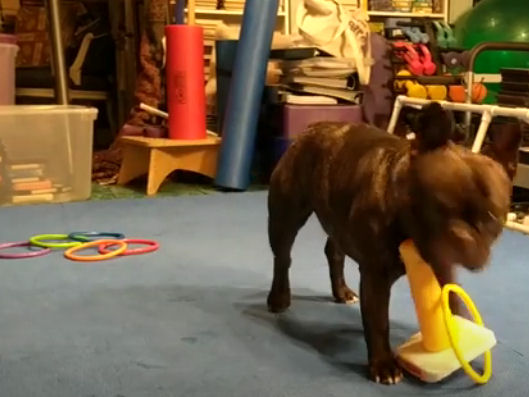Yes, your dog is smarter than a two-year-old!

And you can easily teach your dog the ring stacking game, one of baby’s favorite toy games!
All you need is a post, rings that easily fit on it, some treats, and your dog. We recommend a clicker, too, but it’s not essential. As long as you consistently “mark” good decisions, a word (good!) is fine.
Step by step
When you start teaching your dog something new, break the behavior down into little nuggets that can be assembled into the whole behavior.
With the ring stacking game, start with just one ring. Put it on the floor near your dog. The goal is to get your dog to pick it up, but she doesn’t understand that, yet. Watch carefully. When she looks at the ring, mark it! If she gets close to the ring, mark it! If she sniffs it, mark it! If she picks it up, celebrate! Good dog! Lots of treats!
What if your dog moves the ring with a paw, instead of her mouth? Ignore it. It’s not what you want, and it may cause confusion if you change the criteria later. Mouth? Yes! Paw? Try again, that’s not what we want.
Next on the agenda
The next step is to have your dog move while holding the ring. The easiest way to do this is for you to start moving as soon as the dog has the ring in his mouth. If he drops it, stop. Wait for him to pick it up again and start moving.
At this point, you can place the post you’ll be using to stack the rings. When your dog has the ring in his mouth, move toward the post and wait. At first, if your dog drops it anywhere touching the post, reward. We want to let the dog know that the ring has to touch the post. When he has that idea, we’ll get pickier and expect him to place the ring over the post.
Onward!
We have a total of six rings. We use diving rings because the rings that came with our post were too chubby for our dogs to hold and manipulate easily. Now we toss all six rings down and our dogs, knowing the game, get each one, carry it across, and place it on the post.
If the ring doesn’t go over the post, just wait. The lack of reinforcement (praise and/or treat) will let your dog know it’s not quite right and, hopefully, he will try again.
Here’s a successful session in which Torque completed the game in about a minute with all 6 rings:
Hints for success
Reward for the “same thing” only about three times per session. Looking at the ring is great, but we want to move on after the third time. Picking up the ring is terrific – three times. Then we need more. If you expect your dog to do more, he will!
Keep each session short – that’s why we call it 2-Minute training. Dogs think and process what they’ve learned. The next session, either later or the next day, start with a brief “refresher.” If your dog is stumped, take a step back to the point he/she was successful.
Dogs learn what’s “good” by associating the “thing” with the reward. Try to place your reward (treat) near the post, so your dog knows the post is a good thing. She may not know what to do with it right away, but she’ll be happy to be around it.
This may sound odd, but “show” your dog how the game works. You pick up a ring (you don’t have to use your mouth – you have thumbs!), carry it over, and put it on the post. Dogs do learn by watching.
Try not to be frustrated or lose patience with your dog. If it’s all brand new, it may take some time to catch on to the ring stacking game. Keep in mind that playing only two minutes at a time, a dozen sessions is less than half an hour. Read about a session a while ago when Torque completely forgot how to play the game.
Remember how dogs learn
Just by watching how your dog relates to the game, you’ll be able to see how he/she learns. Some dogs will get it right away. Others will learn one step easily and have difficulty with another. Just like us, all dogs have unique learning styles.
Part of learning is processing. You may have one completely awful game session. The next time, your dog may be brilliant. Giving your dog time to “think” about it helps them achieve success.
If you do have a session that falls off the rails, just stop and regroup. Your dog is doing the best he/she can, willing to play with you. Be grateful for the wonderful companion you have and try again later.
